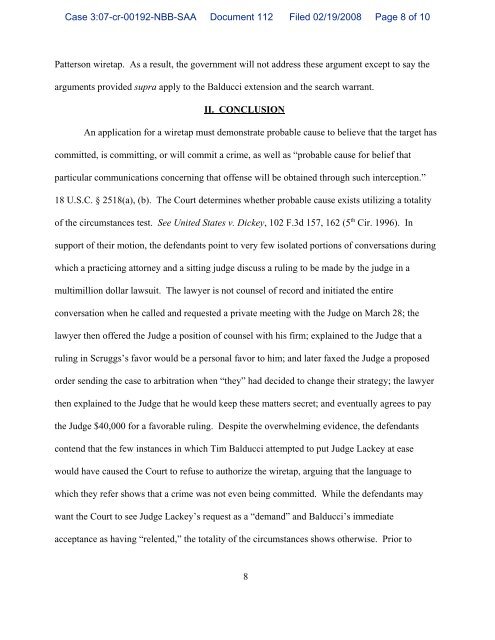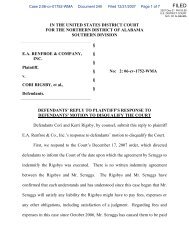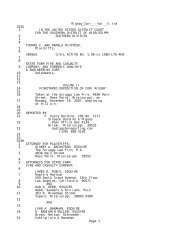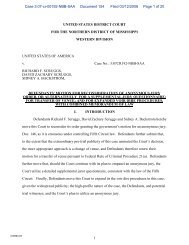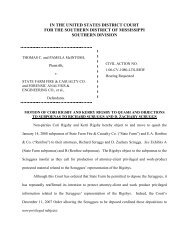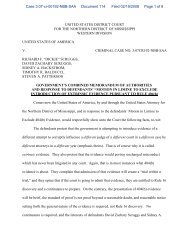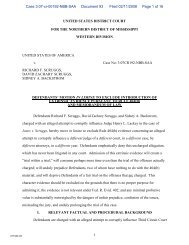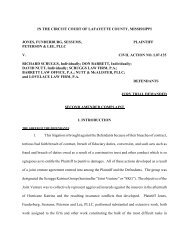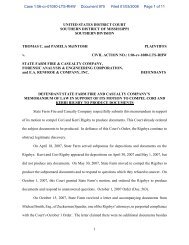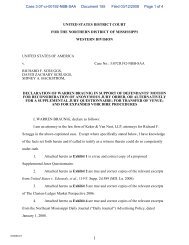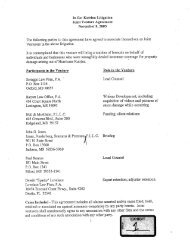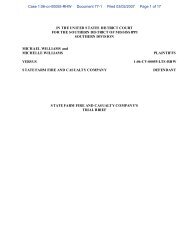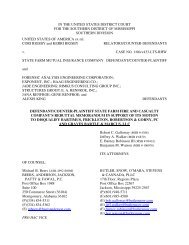motion to suppress the wiretaps - Insurance Coverage Blog
motion to suppress the wiretaps - Insurance Coverage Blog
motion to suppress the wiretaps - Insurance Coverage Blog
Create successful ePaper yourself
Turn your PDF publications into a flip-book with our unique Google optimized e-Paper software.
Case 3:07-cr-00192-NBB-SAA Document 112 Filed 02/19/2008 Page 8 of 10Patterson wiretap. As a result, <strong>the</strong> government will not address <strong>the</strong>se argument except <strong>to</strong> say <strong>the</strong>arguments provided supra apply <strong>to</strong> <strong>the</strong> Balducci extension and <strong>the</strong> search warrant.II. CONCLUSIONAn application for a wiretap must demonstrate probable cause <strong>to</strong> believe that <strong>the</strong> target hascommitted, is committing, or will commit a crime, as well as “probable cause for belief thatparticular communications concerning that offense will be obtained through such interception.”18 U.S.C. § 2518(a), (b). The Court determines whe<strong>the</strong>r probable cause exists utilizing a <strong>to</strong>talityof <strong>the</strong> circumstances test. See United States v. Dickey, 102 F.3d 157, 162 (5 th Cir. 1996). Insupport of <strong>the</strong>ir <strong>motion</strong>, <strong>the</strong> defendants point <strong>to</strong> very few isolated portions of conversations duringwhich a practicing at<strong>to</strong>rney and a sitting judge discuss a ruling <strong>to</strong> be made by <strong>the</strong> judge in amultimillion dollar lawsuit. The lawyer is not counsel of record and initiated <strong>the</strong> entireconversation when he called and requested a private meeting with <strong>the</strong> Judge on March 28; <strong>the</strong>lawyer <strong>the</strong>n offered <strong>the</strong> Judge a position of counsel with his firm; explained <strong>to</strong> <strong>the</strong> Judge that aruling in Scruggs’s favor would be a personal favor <strong>to</strong> him; and later faxed <strong>the</strong> Judge a proposedorder sending <strong>the</strong> case <strong>to</strong> arbitration when “<strong>the</strong>y” had decided <strong>to</strong> change <strong>the</strong>ir strategy; <strong>the</strong> lawyer<strong>the</strong>n explained <strong>to</strong> <strong>the</strong> Judge that he would keep <strong>the</strong>se matters secret; and eventually agrees <strong>to</strong> pay<strong>the</strong> Judge $40,000 for a favorable ruling. Despite <strong>the</strong> overwhelming evidence, <strong>the</strong> defendantscontend that <strong>the</strong> few instances in which Tim Balducci attempted <strong>to</strong> put Judge Lackey at easewould have caused <strong>the</strong> Court <strong>to</strong> refuse <strong>to</strong> authorize <strong>the</strong> wiretap, arguing that <strong>the</strong> language <strong>to</strong>which <strong>the</strong>y refer shows that a crime was not even being committed. While <strong>the</strong> defendants maywant <strong>the</strong> Court <strong>to</strong> see Judge Lackey’s request as a “demand” and Balducci’s immediateacceptance as having “relented,” <strong>the</strong> <strong>to</strong>tality of <strong>the</strong> circumstances shows o<strong>the</strong>rwise. Prior <strong>to</strong>8


